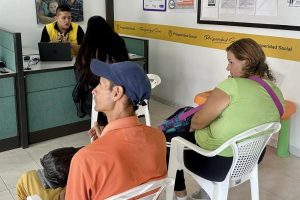Ursula von der Leyen is a leading candidate to preside over the European Commission again, this time adhering to the procedural requirements. The system must be understood for what it is: a way of selecting the European Parliament’s favorite candidate.
Through the lead candidate procedure (or Spitzenkandidaten), European political parties appoint their main candidates with the understanding that the candidate of the party that obtains the greatest number of seats will become president of the European Commission. This worked in 2014, when European People’s Party (EPP) candidate Jean-Claude Juncker became Commission president. However, it was deemed to have failed in 2019, when Ursula von der Leyen was named the (non)main candidate.
Where are we in 2024? Although it is clear that the procedure is still alive, as demonstrated by the selection of candidates who debated on May 21 and the discreet campaign, almost no one seems to believe in it anymore. In fact, it has evolved beyond what it was originally supposed to be, but it has also become somewhat distorted due to the erratic selection of candidates by political parties and the resulting confusion around what a candidate actually is. major.
Von der Leyen did not end the procedure
This year, von der Leyen is a leading candidate. However, she is accused of having damaged the system. Among others, the former president of the European Parliament (and alleged inventor of the procedure) Martin Schulz accused her of being a “false” candidatesince he was not running for a seat in the EP.
This argument does not hold water. Firstly, not even Jean-Claude Juncker (the only successful main candidate so far) ran for a seat in the EP. Secondly, and more importantly, running for an EP seat would mean that von der Leyen would have to appear on the ballot in Lower Saxony, one of Germany’s 16 states, meaning only six of the 380 million eligible EU voters could vote for it directly. Given these figures, requiring him to present himself to the EP is unconvincing and too technocratic.
Five years ago, von der Leyen was elevated to the position because member states could not agree on any of the EP’s main candidates. However, although a non-lead candidate was named president, two of the leading candidates (the social democrat Frans Timmermans and the liberal Margarete Vestager) were ultimately assigned a unique and influential role, that of Executive Vice-Presidents of the Commission. Thus, although the procedure was not used as planned, it did influence the final formation of the College of Commissioners.
Who can be a leading candidate?
When assessing the current health of the procedure, it is essential to remember that it was never perfectly adapted to the EU’s institutional structure in the first place. The EU is based on double legitimacy, that of the Member States (represented in the European Council) and that of European citizens (represented by MEPs). Under the EU Treaties, both have a role in electing the President of the Commission.
Even if it is not a perfect fit for the EU, it is good that the EP has pushed hard for a decision on who will be the president of the Commission. It is a necessary step on the slow and cumbersome path towards a more democratic Union that the powerful rudder of the EU’s main executive is no longer decided only by the heads of State and Government in the European Council.
In this sense, the lead candidate procedure gives visibility and transparency to the selection of the EU leadership. This in itself is an achievement, since “it is said that sunlight is the light that illuminates best.” That said, the appointment of the Commission president is likely to remain a (sometimes tedious) negotiation process between these two institutions.
This means that the EU should not completely scrap the procedure, nor require it to be strictly applied (such as forcing all candidates to stand for an EP seat). On the contrary, it must be understood for what it is: a modus operandi to select the EP’s favorite candidate.
The European Council has the right to nominate a candidate who is not the head of the list and could do so again. So, although the procedure may not be what its inventors had in mind, it may be a process to identify a pool of candidates for all kinds of interesting positions – including commissioners -, as happened in 2019 with Timmermans and Vestager.
Another question is whether this unprecedented partisan politicization of the College of Commissioners is desirable. But it can be seen as an opportunity for European political parties to get interesting positions in the Commission for their candidates.
Attractive candidates are of course a precondition, as they have a better chance of being elected by the Member States to the Commission Presidency or other senior positions. However, the procedure cannot guarantee his appointment, which may make political heavyweights reluctant to leave their current positions to run. Internal party processes can also work against identifying the most promising candidate. In 2019, Manfred Weber failed to convince the European Council – not even members of his own party – despite having obtained much more support at the previous EPP Congress in Helsinki than his competitor, Alexander Stubb.
However, political parties…
Unfortunately, this year’s (mostly unknown) leading candidates indicate that political parties have not yet grasped that the procedure has evolved beyond its original intent. Consequently, his chances of winning a senior position in the Commission this time could be cut short. A good example is the Renew Europe group, which could not agree on one candidate and instead sent three.
This is arguably undermining the system more than von der Leyen could have done by not running for a seat in the European Parliament. He Maastricht debate of April 29 demonstrated the conceptual confusion (and unnecessary complication) of the term main candidate. A myriad of different candidates, some from unknown parties, that do not clarify who represents whom and where.
European political parties keep the system alive by continuing to nominate candidates, round after round. But, at the same time, they have weakened it with an ambiguous selection of candidates and the effective creation of different guys of main candidates. We’ll see if this is fixed by 2029, if the system still exists by then.
Article translated from English from the website CEPS.
Activity subsidized by the Ministry of Foreign and Global Affairs.















Add Comment